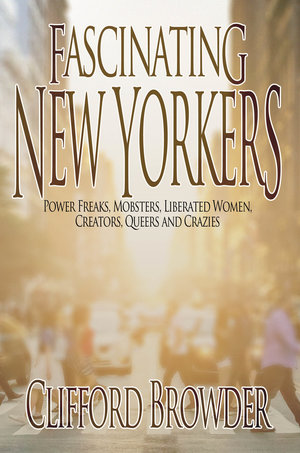Small Talk: An Adventurous Young Man
 |
At the time of this photo, there are two things that Mother doesn't know about son Robert, who still lives at home in Jersey City with his parents.
(1) He is gay and recently had his first sex experience with a man named Ted who offered "to keep you good."
(2) He is also having an affair with Hortense.
Bob later learns not only that Ted is married, with a family, but also that he is a famous jockey who, having won many races, is a multimillionaire. Meanwhile Bob has discovered a gay bar in New York where, with Hortense's full knowledge (but not her consent), he dances wildly and begins to connect with other lovers.
All this while he is a full-time college student at Rutgers Newark, where he hopes to get his plays done by the Theater Department. Also, he is going to burlesque shows not for thrills but for laughs, and has fallen in love with a heterosexual friend whom Bob has come out to. Clearly, this young man has an immense appetite for life.
All of which made for rather busy college year, and has inspired me to sort out and organize his voluminous files -- correspondence, journals, and photo albums -- in hopes of doing a biography of Bob that, with additions by me, will tell what it was like to be gay in the 1950s, 1960s, 1970s. His files yield multiple secrets, some shocking, some puzzling, some amusing, of which this brief account gives only a hint. And his story often reads like a novel, or better still like an ongoing TV soap. Example: What happens when Bob's parents notice that he's spending an awful lot of time with Hortense, and his father bars "that woman" from the house? And how does Bob react when Hortense falls deeply in love with him, proclaiming him the great love of her life, even though she knows Bob frequents a gay dance bar in New York? And what does Bob do, when Hortense vows to "save" him from the boys?
 |
| Will she save him from the boys? |
Are squibs like this about Bob's adventurous life of interest today? If so, I'll do more. If not, there are alternatives. Please, dear viewers, let me know your preference.
When Grandma Burns Your House Down
If Grandma fumes and broods, make nice with her. If she blows her top, don't argue, run for your life. And if she burns your house down, shrug it off and build another. Above all, remember that she's kin.
So it goes on Hawaii, the biggest of the Hawaiian Islands. Recently, when Grandma exploded and the earth shook, the people pointed to the home of Pele (pronounced PEH-leh). “She is coming down to play,” said a poet as she fled. “There is nothing to do when Pele makes up her mind but accept her will.”
“My house was an offering for Pele,” said a retired
schoolteacher whose home Pele had once destroyed. “I’ve been in her backyard for thirty
years. I have learned that Pele created
this island in all its stunning beauty.
It’s an awe-inspiring process of destruction and creation, and I was
lucky to glimpse it.”
During the recent crisis some residents made offerings to
Pele of crystals, money, incense, and cooked foods. Others ventured near smoking fissures in the
earth to place leaves of the palm lily there, and still others raised their
arms in entreaty and awe against a fiery ruddy sky.
 |
| Worldtraveler |
Since President Trump
has at times dismissed global warning as “nonsense” and a Chinese-inspired
“hoax,” I have taken an interest in how Hawaiians deal with the constant threat
of volcanic eruptions and the loss of their homes to lava. What they have to contend with I have seen in a video showing the crater hurling forth pellets of fire followed by oozing masses of lava. Faced with this destructive force that they
cannot control, native Hawaiians show a wisdom that I have to admire. They don’t curse Pele or try to change her
ways, which over the centuries have not changed. Instead, they revere her and express
admiration and awe at the spectacle of her dramatic eruptions. When we Americans annexed the Hawaiian
Islands in 1898, we were too ”civilized,” too “modern,” to appease Pele and
accept her fiery ways. In 1935, when he was the U.S. Army’s chief intelligence officer in Hawaii, General George S. Patton, the future war hero, tried a bit of violence of his own: he bombed the Mauna Loa
volcano in an attempt to divert it.
That tactic had mixed results at best, and the people of Hawaii
preferred to revere and appease Pele, as they had done for centuries and still do. They have even made her kin, calling her
Madame Pele or Tutu Pele, an affectionate term for grandmother, and honor her
as the creator of the islands. They even
go so far as to call themselves her
descendants, thus following the old injunction, “If you cant lick ’em, join
’em.” Hawaiians worship 40,000 gods, a
hula teacher and lecturer on Hawaiian culture explains, but Pele ranks high
among them, for she created Hawaii and represents that primordial force
existing in all land masses. Paintings
of her, often showing a red-robed woman with long black hair cradling fire in
her hands, hang in shops or are painted on walls of schools. Visitors can dine at Pele’s Kitchen or stay
in a bed-and-breakfast called Pele’s Breath.
And a popular bumper sticker on trucks plying bumpy back roads proclaims
PELE
IS MY HOMEGIRL.
Visitors share in the natives’ awe of Pele, an intrusion
that the natives at times resent. A
bearded Pennsylvanian who calls himself Son of Pele on social media recently
did yoga within a few feet of her lava flow, grinning as police called on him
to retreat. He said that, after seeing
Pele up close, he felt energy beyond anything he had ever experienced. But Pele can be vengeful. Some natives say that she is getting angry
about these intrusions by outsiders who know nothing of her ways. Many Hawaiians like to describe how stoic
they are in accepting her destruction, while others, seeing her as sacred,
prefer not to divulge too much about her.
She can appear in human form, explains a hula dancer and evacuee, so if
you see her hitchhiking, be sure to pick her up. And since she likes gin, offer her some. And always remember that, like her
descendants, she enjoys a little mischief.
Mischief in the form of volcanic eruptions, earthquakes, and lava flows
that eat up homes.
I don’t scorn or scoff at how Hawaiians have
learned to live with their fiery volcano, for I see wisdom in their ways. Faced with a destructive force they cannot
control, they have made of her a fickle goddess, a loving but moody grandmother, a creator, and almost a
lover. Are we doing better, confronted
with climate changes that some of us still refuse to even acknowledge, much
less take responsibility for or at least accept?
Source note: This post was inspired by an article by Simon Romero and Tamir Kalifa,"Goddess of Volcanoes Awes All in Lava's Path," in the New York Times of May 22, 2018.
Coming soon: Antics of the Gilded Age: getting accepted by the Mystic Rose.
BROWDERBOOKS
If you love the city (or hate it), this may be the book for you. An award winner, it sold well at BookCon 2017 and 2018, and at the Brooklyn Book Festival 2018.
"If you want wonderful inside tales about New York, this is the book for you. Cliff Browder has a way with his writing that makes the city I lived in for 40 plus years come alive in a new and delightful way. A refreshing view on NYC that will not disappoint." Five-star Amazon customer review by Bill L.
Available from Amazon and Barnes & Noble.
"A real yarn of a story about a lovable pickpocket who gets into trouble and has a great adventure. A must read." Five-star Amazon customer review by nicole w brown.
"This was a fun book. The main character seemed like a cross between Huck Finn and a Charles Dickens character. I would recommend this." Four-star LibraryThing review by stephvin.
"I am glad that I have read this book as it goes into great detail and the presentation is amazing. The Author obviously knows his stuff." Four-star LibraryThing early review by Moiser20.
Available from Amazon and Barnes & Noble.
"At times amusing, gritty, heartfelt and a little sexy -- this would make a great summer read." Four-star Amazon customer review by BobW.
"Really more of a fantasy of a 19th century gay life than any kind of historical representation of the same." Three-star Goodreads review by Rachel.
Available from Amazon and Barnes & Noble.

Source note: This post was inspired by an article by Simon Romero and Tamir Kalifa,"Goddess of Volcanoes Awes All in Lava's Path," in the New York Times of May 22, 2018.
Coming soon: Antics of the Gilded Age: getting accepted by the Mystic Rose.
BROWDERBOOKS
All books are available online as indicated, or from the author.
1. No Place for Normal: New York / Stories from the Most Exciting City in the World (Mill City Press, 2015). Winner of the Tenth Annual National Indie Excellence Award for Regional Non-Fiction; first place in the Travel category of the 2015-2016 Reader Views Literary Awards; and Honorable Mention in the Culture category of the Eric Hoffer Book Awards for 2016. All about anything and everything New York: alcoholics, abortionists, greenmarkets, Occupy Wall Street, the Gay Pride Parade, my mugging in Central Park, peyote visions, and an artist who made art of a blackened human toe.
If you love the city (or hate it), this may be the book for you. An award winner, it sold well at BookCon 2017 and 2018, and at the Brooklyn Book Festival 2018.
 |
Reviews
"If you want wonderful inside tales about New York, this is the book for you. Cliff Browder has a way with his writing that makes the city I lived in for 40 plus years come alive in a new and delightful way. A refreshing view on NYC that will not disappoint." Five-star Amazon customer review by Bill L.
"To read No Place for Normal: New York is to enter into Cliff Browder’s rich and engaging sixty years of adult life in New York. Yes, he delves back before his time – from the city’s origins to the 19th Century that Ms. Trollope and Mr. Dickens encounter to robber barons and slums that marked highs and lows of the earlier Twentieth Century. But Browder has lived such an engaged and curious life that he can’t help but cross paths with every layer and period of society. There is something Whitmanesque in his outlook." Five-star Amazon customer review by Michael P. Hartnett.
Available from Amazon and Barnes & Noble.
2. Bill Hope: His Story (Anaphora Literary Press, 2017), the second novel in the Metropolis series. New York City, 1870s: From his cell in the gloomy prison known as the Tombs, young Bill Hope spills out in a torrent of words the story of his career as a pickpocket and shoplifter; his brutal treatment at Sing Sing and escape from another prison in a coffin; his forays into brownstones and polite society; and his sojourn among the “loonies” in a madhouse, from which he emerges to face betrayal and death threats, and possible involvement in a murder. Driving him throughout is a fierce desire for better, a persistent and undying hope.
Reviews
"A real yarn of a story about a lovable pickpocket who gets into trouble and has a great adventure. A must read." Five-star Amazon customer review by nicole w brown.
"This was a fun book. The main character seemed like a cross between Huck Finn and a Charles Dickens character. I would recommend this." Four-star LibraryThing review by stephvin.
Available from Amazon and Barnes & Noble.
3. Dark Knowledge (Anaphora Literary Press, 2018), the third novel in the Metropolis series. Adult and young adult. A fast-moving historical novel about New York City and the slave trade, with the sights and sounds and smells of the waterfront.
 |
New York City, late 1860s. When young Chris Harmony learns that members of his family may have been involved in the illegal pre-Civil War slave trade, he is appalled. Determined to learn the truth, he begins an investigation that takes him into a dingy waterfront saloon, musty old maritime records that yield startling secrets, and elegant brownstone parlors that may have been furnished by the trade. Since those once involved dread exposure, he meets denials and evasions, then threats, and a key witness is murdered. What price must Chris pay to learn the painful truth and proclaim it?
Reviews
"A lively and entertaining tale. The writing styles, plot, pace and character development were excellent." Four-star LibraryThing early review by BridgitDavis.
"A lively and entertaining tale. The writing styles, plot, pace and character development were excellent." Four-star LibraryThing early review by BridgitDavis.
"At first the plot ... seemed a bit contrived, but I was soon swept up in the tale." Four-star LibraryThing early review by snash.
"I am glad that I have read this book as it goes into great detail and the presentation is amazing. The Author obviously knows his stuff." Four-star LibraryThing early review by Moiser20.
4. The Pleasuring of Men (Gival Press, 2011), the first novel in the Metropolis series, tells the story of a respectably raised young man who chooses to become a male prostitute in late 1860s New York and falls in love with his most difficult client.
What was the gay scene like in nineteenth-century New York? Gay romance, but women have read it and reviewed it. (The cover illustration doesn't hurt.)
What was the gay scene like in nineteenth-century New York? Gay romance, but women have read it and reviewed it. (The cover illustration doesn't hurt.)
 |
Reviews
"At times amusing, gritty, heartfelt and a little sexy -- this would make a great summer read." Four-star Amazon customer review by BobW.
"Really more of a fantasy of a 19th century gay life than any kind of historical representation of the same." Three-star Goodreads review by Rachel.
"The detail Browder brings to this glimpse into history is only equaled by his writing of credible and interesting characters. Highly recommended." Five-star Goodreads review by Nan Hawthorne.
Available from Amazon and Barnes & Noble.
5. Fascinating New Yorkers: Power Freaks, Mobsters, liberated Women, Creators, Queers and Crazies (Black Rose Writing, 2018). A collection of posts from this blog. Short biographical sketches of people, some remembered and some forgotten, who lived or died in New York. All kinds of wild stuff, plus some stuff that isn't quite wild but fascinating. New York is a mecca for hustlers of every kind, some likable and some horrible, but they are never boring.

Reviews
"Fascinating New Yorkers by Clifford Browder was like sitting down with a dear friend and catching up on the latest gossip and stories. Written with a flair to keep the reader turning the pages, I couldn't stop reading it and thinking about the subjects of each New Yorker. I love NYC and this book just added to the list of reasons why, a must read for those who love NYC and the people who have lived there." Five-star NetGalley review by Patty Ramirez, librarian.
"Unputdownable." Five-star review by Dipali Sen, retired librarian.
"I felt like I was gossiping with a friend when reading this, as the author wrote about New Yorkers who are unique in one way or another. I am hoping for another book featuring more New Yorkers, as I couldn't put this down and read it in one sitting!" Five-star NetGalley review by Cristie Underwood.
© 2018 Clifford Browder

No comments:
Post a Comment